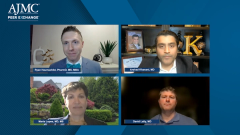
Real World Evidence Supporting GA Therapy Management Strategies
Dr Khanani discusses how to monitor patients with geographic atrophy for adverse events.
Episodes in this series

Ryan Haumschild, PharmD, MS, MBA: We’ve talked a lot about real-world evidence, and Dr Khanani, I know you’re excited as well because a lot of times we want to wait for a randomized clinical controlled trial to be developed and accrue but sometimes that can be up to 6 years. A lot of times we want to know how patients are performing in the real world. What are the adverse events? What are the things that we’re seeing? My question to you is, in the real-world setting, how will responses to these complement inhibitors be monitored? And do you expect to manage patients? How do you expect to manage these patients who experience adverse events or maybe even inadequate response to therapy? I think just taking it a step further, if this summer we do have a few agents on the market, we’ll even consider switching between therapies. Is that even something that you would look at? I’d love to hear your response to that.
Arshad Khanani, MD: I think the biggest question the field is struggling with is what is efficacy when it comes to a real-world patient. Because, in trials, you saw a certain percent of efficacy, but that’s average. There are patients who benefit a lot from treatment. There are patients who don’t benefit too much from treatment. And because it’s a variable disease with so many factors, as we discussed earlier in this program, it’s a multifactorial disease. It’s very hard to know how good a therapy is working because you would have to take the therapy off to know how that trajectory is looking. Let’s say I have a patient that I’ve seen for 5 years and I can look at the fundus autofluorescence [FAF] and measure the growth rate every year for that patient, then I put them on complement inhibitors, and then I can look at the growth rate after a year on treatment or 2 years on treatment. Then I’ll be able to see, OK, if I can slow down the progression or the rate of growth, then I’m making an impact for that patient. In terms of treatment, I think once patients commit to it, it’s kind of a lifetime of treatment. And we will do OCT [optical coherence tomography] every time we see them to make sure they’re not developing CMV [cytomegalovirus retinitis] or wet macular degeneration, which is seen with complement inhibition. And if we do, we treat neovascular wet AMD [age-related macular degeneration] concurrently so that they don’t have vision loss from wet AMD. Then I would get the FAF every 6 months and measure the area of the lesion and then compare it to the historicals if we have it. If you don’t have the historical, then all we can do is keep a track of the size of the lesion. The trouble obviously is that the disease is going to grow. We are not stopping it completely. So I think there’s going to be variable efficacy we see based on the patient profile, the baseline size of the lesion, and there are specific characteristics that can make the lesions grow faster or slower. But I think at the end of the day, as a physician, as Dr Lally said, and I said earlier, we have to offer it to all of our patients because the quality of life and independence are super important to patients. And some of these patients with central GA [geographic atrophy] lesions may still have impacted vision. The label, at least for pegcetacoplan [Syfovre], and I hope also for ACP [avacincaptad pegol], will allow us to treat any GA. I think that’s where we need as a community to offer it to all of our patients and see. But I think monitoring will be based on FAF every 6 months or so, OCT every time. Now, the adverse events, let’s say somebody gets inflammation from pegcetacoplan, then do we continue or not continue? That’s a really good question. Or do we wait for ACP? And how do we switch between pegcetacoplan to ACP? I think those are the questions. Some patients may not want to get pegcetacoplan because of the safety profile on the label, and they may say, “OK, is there anything else coming?” And you say, “Well, yes, and the safety looks better,” as we discuss in terms of intraocular inflammation, ischemic optic neuropathy, and even CNV [choroidal neovascularization] rate is lower than the patients may want to wait for that treatment. I think there’s a lot to be learned about real-world utilization, Ryan, and obviously, all physicians will do what they think is appropriate for the patient. And as you said earlier, it’s important to have patients commit to this treatment and be part of this conversation.
Transcript edited for clarity.
Newsletter
Stay ahead of policy, cost, and value—subscribe to AJMC for expert insights at the intersection of clinical care and health economics.





























































